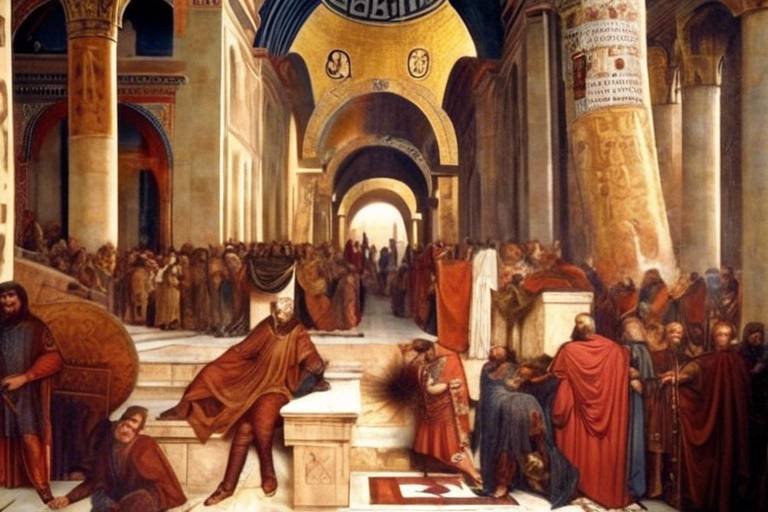The Cultural Richness of the Aksumite Empire
When delving into the cultural richness of the Aksumite Empire, one cannot help but marvel at the myriad of facets that defined this ancient civilization. From its artistic achievements to architectural marvels, religious practices, language and script, trade networks, social structure, and enduring legacy, the Aksumites left an indelible mark on history that continues to captivate scholars and enthusiasts alike.
Artistically, the Aksumites were known for their unique expressions showcased in sculptures, obelisks, and coinage. These artistic endeavors reflected a harmonious blend of local traditions with influences from Egypt, Rome, and Arabia, creating a distinctive visual language that set them apart from their contemporaries.
Architecturally, the Aksumites excelled in creating monumental structures such as the stelae fields, royal tombs, and iconic ruins of palaces and churches. Their advanced building techniques and design aesthetics not only served practical purposes but also symbolized the grandeur and sophistication of their civilization.
Religiously, the Aksumites embraced a diverse spiritual landscape, eventually adopting Christianity as a state religion in the 4th century AD. This religious transformation, alongside the enduring influences of Judaism and indigenous spiritual traditions, shaped the spiritual fabric of the empire and influenced its cultural practices.
Language and script played a pivotal role in Aksumite society, with the unique Ge'ez language and script serving as the foundation for written communication, literature, and religious texts in ancient Ethiopia and Eritrea. The development of these linguistic elements contributed to the preservation and dissemination of knowledge within the empire.
The Aksumite Empire's strategic location along the Red Sea coast facilitated extensive trade networks that connected Africa with the Mediterranean world. This vibrant economic exchange not only bolstered the empire's prosperity but also enriched its cultural landscape through the exchange of goods, ideas, and technologies.
Socially, the Aksumites had a well-defined hierarchical structure that encompassed the king, nobility, priests, merchants, and commoners. Each segment of society played a crucial role in maintaining political stability and cultural identity, contributing to the empire's overall cohesion and resilience.
The legacy of the Aksumite Empire endures in modern-day Ethiopia and Eritrea, evident in the region's religious traditions, architectural heritage, and cultural identity. The influence of the Aksumites continues to shape the cultural landscape of the Horn of Africa, serving as a testament to their enduring impact on the region.
However, the once-mighty Aksumite Empire eventually faced a decline and disappearance, attributed to factors such as environmental changes, political instability, and external invasions. These challenges marked the end of an era in African history, underscoring the impermanence of even the most illustrious civilizations.

Artistic Achievements
Exploring the diverse cultural aspects of the ancient Aksumite Empire, including art, architecture, religion, language, trade, and societal structure that contributed to its significance in history.
Highlighting the unique artistic expressions of the Aksumites through their sculptures, obelisks, and coinage, reflecting a blend of local traditions with influences from Egypt, Rome, and Arabia.
The artistic achievements of the Aksumite Empire stand as a testament to their creativity and cultural richness. The sculptures crafted by Aksumite artisans were not mere representations but intricate pieces of art that captured the essence of their society. The towering obelisks, some reaching over 20 meters in height, served as symbols of power and religious devotion, adorned with intricate carvings that depicted scenes from daily life and religious ceremonies. The coinage of the Aksumites, bearing images of rulers and religious symbols, showcased their advanced metallurgical skills and artistic flair.
These artistic endeavors were not isolated but rather a fusion of diverse influences. The Aksumites drew inspiration from the artistic traditions of Egypt, incorporating elements of pharaonic art into their own creations. Roman artistic styles also left a mark on Aksumite sculptures and architecture, blending seamlessly with indigenous motifs to form a unique visual language. Additionally, the trade connections of the empire brought influences from Arabia, enriching their artistic repertoire with new techniques and designs.
In essence, the artistic achievements of the Aksumite Empire were a reflection of their cosmopolitan nature, blending local traditions with external influences to create a cultural tapestry that was both distinctive and influential in the ancient world.

Architectural Marvels
The Aksumite Empire, renowned for its architectural marvels, left a lasting legacy through its impressive structures that still stand as testaments to their advanced building techniques and design aesthetics. Among the most striking architectural achievements of the Aksumites are the stelae fields, where towering obelisks were erected to commemorate rulers and important events. These monolithic structures, some reaching over 20 meters in height, showcase the engineering prowess of the Aksumites and their ability to create monumental works of art.
In addition to the stelae fields, the Aksumite Empire is also known for its royal tombs, which were elaborately constructed to house the remains of kings and nobility. These tombs, often carved out of solid rock, feature intricate carvings and decorations that reflect the wealth and prestige of the Aksumite rulers. The architectural style of these tombs reveals a blend of indigenous traditions with influences from neighboring regions, creating a unique and distinctive aesthetic.
Furthermore, the iconic ruins of palaces and churches in Aksum provide further insight into the architectural prowess of the empire. The remains of grand palaces, with their intricate layouts and decorative elements, offer a glimpse into the opulent lifestyle of the Aksumite elite. Meanwhile, the churches of Aksum, such as the famous Church of St. Mary of Zion, exemplify the fusion of indigenous architectural styles with Christian influences, showcasing the empire's religious and cultural diversity.
Overall, the architectural marvels of the Aksumite Empire stand as a testament to the ingenuity and creativity of this ancient civilization, highlighting their ability to create enduring structures that continue to captivate and inspire visitors to this day.

Religious Practices
Religious practices held a significant place in the cultural fabric of the Aksumite Empire, shaping the beliefs and rituals of its people. The Aksumites were known for their religious diversity, with influences from Judaism, indigenous spiritual traditions, and eventually Christianity. The empire's embrace of Christianity as a state religion in the 4th century AD marked a pivotal moment in its history, solidifying its ties to the Christian world and leaving a lasting impact on the region.
The Aksumites' religious practices were intertwined with their daily lives, influencing everything from governance to social customs. Priests played a crucial role in religious ceremonies and rituals, acting as intermediaries between the people and the divine. Temples and sacred sites dotted the landscape, serving as centers of worship and pilgrimage for the faithful.
The adoption of Christianity brought about a transformation in the religious landscape of the empire, leading to the construction of churches and monasteries that still stand as testaments to the enduring legacy of Aksumite Christianity. The Aksumites' religious beliefs also influenced their art and architecture, with Christian motifs and symbols adorning their monuments and artifacts.
Despite the influence of Christianity, elements of Judaism and indigenous spiritual practices continued to coexist within Aksumite society, reflecting the empire's cultural richness and tolerance towards diverse beliefs. The fusion of these different religious traditions created a unique tapestry of faith that defined the spiritual life of the Aksumites.
Overall, the religious practices of the Aksumite Empire played a crucial role in shaping its identity and cultural heritage, leaving a lasting legacy that is still visible in the religious traditions of modern-day Ethiopia and Eritrea.

Language and Script
Language and script were integral components of the Aksumite Empire, playing a crucial role in shaping its cultural identity and facilitating communication within the region. The Aksumites primarily used Ge'ez, a unique language that evolved from the ancient Semitic languages, and developed their own script to record important historical events, religious texts, and administrative documents.
The Ge'ez script, known as the Ge'ez abugida, featured a combination of consonant-vowel characters that allowed for the representation of complex syllables. This script was essential for the dissemination of knowledge and the preservation of the Aksumite heritage through written texts inscribed on stone monuments, manuscripts, and coins.
Moreover, the Aksumites' mastery of the Ge'ez script enabled them to create a rich literary tradition, producing religious manuscripts, epic poems, and historical chronicles that documented the empire's achievements and cultural practices. The script served as a vehicle for transmitting oral traditions and philosophical insights, fostering intellectual discourse and spiritual enlightenment among the populace.
Through the Ge'ez language and script, the Aksumites established a strong foundation for educational institutions, where scribes and scholars honed their writing skills and expanded their knowledge of various subjects. This linguistic heritage not only facilitated internal communication but also enabled the Aksumite Empire to engage in diplomatic relations with neighboring kingdoms and distant empires, showcasing their intellectual sophistication and diplomatic prowess.

Trade Networks
Trade played a pivotal role in the prosperity and cultural exchange of the Aksumite Empire. Situated strategically along the Red Sea coast, the empire established extensive trade networks that connected Africa with the Mediterranean world. This advantageous location allowed the Aksumites to engage in lucrative commerce, trading goods such as ivory, gold, spices, and exotic animals.
The Red Sea trade routes facilitated by the Aksumites enabled the exchange of commodities with distant regions, contributing to the economic growth and influence of the empire. Through these networks, Aksum became a significant hub for transcontinental trade, attracting merchants from various civilizations seeking valuable resources and luxury items.
Moreover, the Aksumite trade networks not only boosted the empire's economic power but also fostered cultural interactions and the exchange of ideas. The flow of goods and people along these routes led to the diffusion of artistic styles, architectural influences, religious beliefs, and technological innovations, enriching the cultural tapestry of the Aksumite society.
Traders from the Aksumite Empire ventured far and wide, establishing commercial ties with regions as distant as Egypt, Arabia, Persia, and the Roman Empire. This extensive network of trade routes not only brought wealth and prosperity to Aksum but also facilitated the spread of its cultural influence across borders, leaving a lasting impact on the interconnected civilizations of the ancient world.

Social Structure
The social structure of the Aksumite Empire was a complex system that defined the hierarchy and roles of different societal groups. At the pinnacle of the structure stood the king, who held absolute power and authority over the empire. The king was not only a political leader but also a religious figure, symbolizing the divine connection between the ruling elite and the spiritual realm. Below the king were the nobility, comprising aristocratic families who held significant wealth and influence. They played a crucial role in advising the king, governing provinces, and overseeing religious ceremonies.
The priests held a revered position in Aksumite society, serving as intermediaries between the people and the gods. They conducted religious rituals, maintained temples, and preserved sacred texts. The priests were instrumental in promoting the adoption of Christianity as the state religion, which reshaped the spiritual landscape of the empire. Alongside the priests, merchants formed a vital segment of Aksumite society, engaging in long-distance trade that connected the empire to distant lands and brought prosperity to its inhabitants.
The majority of the population consisted of commoners, who were farmers, craftsmen, and laborers contributing to the economic sustenance of the empire. Despite their lower social status, commoners played a crucial role in supporting the infrastructure, agriculture, and cultural activities of Aksumite society. The social structure of the empire was characterized by a delicate balance of power and responsibilities among different classes, ensuring the stability and cohesion of the Aksumite civilization.

Legacy and Influence
When it comes to the legacy and influence of the Aksumite Empire, one cannot underestimate the profound impact it has had on the cultural landscape of modern-day Ethiopia and Eritrea. The remnants of this ancient civilization continue to shape the identity of the region, leaving a lasting imprint on various aspects of society.
One of the most notable legacies of the Aksumite Empire is its contribution to religious traditions. The empire played a pivotal role in the early spread of Christianity in the region, with Aksum becoming one of the first Christian states in the world. The iconic rock-hewn churches of Lalibela, a UNESCO World Heritage site, stand as a testament to the enduring influence of Aksumite Christianity.
Furthermore, the architectural heritage of the Aksumites continues to inspire awe and admiration. The stelae fields, towering obelisks carved from single blocks of stone, are a striking symbol of the empire's grandeur and engineering prowess. These monumental structures serve as a reminder of the Aksumites' advanced building techniques and artistic sophistication.
Moreover, the Aksumite Empire's role as a hub of trade and cultural exchange left a lasting impact on the region. The empire's strategic location along the Red Sea coast facilitated the exchange of goods, ideas, and technologies between Africa and the Mediterranean world. This vibrant trade network not only fueled economic prosperity but also enriched the cultural fabric of the empire.
Despite its eventual decline, the Aksumite Empire's legacy lives on through its contributions to written communication and literature. The Ge'ez script, developed by the Aksumites, played a crucial role in preserving religious texts and historical records, laying the foundation for the rich literary tradition of Ethiopia and Eritrea.
In conclusion, the legacy of the Aksumite Empire endures through its architectural marvels, religious heritage, trade networks, and literary achievements. By delving into the cultural richness of this ancient civilization, we gain a deeper appreciation for the enduring influence of the Aksumites on the cultural identity of the region.

Decline and Disappearance
As the Aksumite Empire entered the 7th century AD, it faced a series of challenges that ultimately led to its decline and disappearance from the historical stage. One of the significant factors contributing to this downfall was the environmental changes that affected the region, leading to shifts in agricultural productivity and resource availability. The once fertile lands of Aksum began to face droughts and soil degradation, impacting the empire's ability to sustain its population and economy.
Furthermore, political instability within the empire exacerbated its decline. Power struggles among the ruling elite, succession disputes, and internal conflicts weakened the central authority of the Aksumite state. This internal turmoil made it difficult for the empire to effectively govern its territories and maintain cohesion among its diverse population.
External invasions also played a crucial role in the downfall of the Aksumite Empire. The rise of neighboring powers, such as the Islamic Caliphate and the expanding Islamic influence in the region, posed significant military threats to Aksum. These external pressures, coupled with internal discord, eroded the empire's military strength and territorial control, ultimately leading to its fragmentation and eventual disappearance.
Despite its decline and disappearance as a political entity, the legacy of the Aksumite Empire continues to endure in the cultural and historical heritage of Ethiopia and Eritrea. The architectural marvels, religious traditions, and linguistic contributions of the Aksumites have left a lasting impact on the identity of the region, serving as a reminder of the empire's once glorious past and its significance in African history.
Frequently Asked Questions
- What were the main artistic achievements of the Aksumite Empire?
The Aksumite Empire was known for its unique artistic expressions, including sculptures, obelisks, and coinage that reflected a blend of local traditions and influences from Egypt, Rome, and Arabia.
- What are some examples of architectural marvels built by the Aksumites?
The Aksumites built impressive structures such as stelae fields, royal tombs, and iconic ruins of palaces and churches, showcasing their advanced building techniques and design aesthetics.
- How did religion play a role in the Aksumite Empire?
Religious practices in the Aksumite Empire included the adoption of Christianity as a state religion in the 4th century AD, alongside influences from Judaism and indigenous spiritual traditions.
- What was the significance of trade networks in the Aksumite Empire?
The Aksumites had extensive trade networks along the Red Sea coast, connecting Africa with the Mediterranean world, which contributed to economic prosperity and cultural exchange.
- What was the social structure like in the Aksumite Empire?
The social hierarchy in the Aksumite Empire included the king, nobility, priests, merchants, and commoners, all playing roles in shaping the empire's political stability and cultural identity.
- What led to the decline and disappearance of the Aksumite Empire?
Factors such as environmental changes, political instability, and external invasions contributed to the decline and eventual disappearance of the Aksumite Empire, marking the end of an era in African history.



















